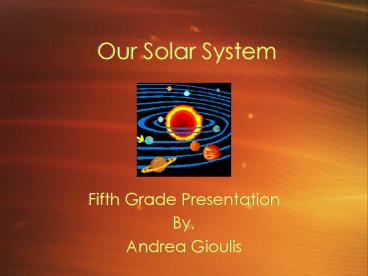Our Solar System - PowerPoint PPT Presentation
1 / 15
Title:
Our Solar System
Description:
... from the sun, are Mercury, Venus, Earth, Mars, Jupiter, ... There is no air or water on Mercury. Venus ... Mercury Uranus. Venus Neptune. Earth Pluto. Mars ... – PowerPoint PPT presentation
Number of Views:82
Avg rating:3.0/5.0
Title: Our Solar System
1
Our Solar System
- Fifth Grade Presentation
- By,
- Andrea Gioulis
2
Our Solar System
- The sun is a star with nine planets orbiting
around it. - This family of planets is called the solar
system. - The planets all travel around the sun in the same
direction, and are held in orbit by the
gravitational pull of the sun. - The orbits of the planets are slightly elliptical
in shape. - The nine known planets, in order of distance from
the sun, are Mercury, Venus, Earth, Mars,
Jupiter, Saturn, Neptune, and Pluto.
3
This is a computer generated image of our solar
system.
4
The Sun
- The sun is a star which is the center of our
solar system. - The sun is composed of gases.
- It has a diameter of 1,400,00 km.
- Temperatures on the sun can reach as high as
15,000,000 Kelvin.
5
Mercury
- Mercury is the smallest planet.
- It is the closest planet to the sun, and this
accounts for its extremely high surface
temperatures. - There is no air or water on Mercury.
6
Venus
- Next to the sun and moon, Venus is the brightest
object in the sky. - Venus has very heavy cloud cover and strong
surface winds.
7
Earth
- Three fourths of the Earths surface is covered
with water. - The entire pleat is surrounded by an immense body
of air called the atmosphere. - Earth has one natural satellite, the moon.
8
Mars
- Mars shines with a reddish glow. The reddish
color of the soil is due to the rusting of iron
rich minerals as they react with the soil and
water. - The Polar Caps of Mars are 1-3 km thick and are
more extensive during the Martian winter. - Mars has two natural satellites, Phobos and
Deimos.
9
Jupiter
- Jupiter is the largest planet in the solar
system. - The surface of Jupiter has light and dark bands
of gaseous clouds covering its liquid hydrogen
core. - A striking feature of this planet is the Great
Red Spot, which changes periodically in color and
brightness.
10
Saturn
- Saturn is the second largest planet in our solar
system. - It is known to have at least 21 moons.
- Saturn is a unique planet because it has many
rings.
11
Uranus
- Uranus is the third largest planet.
- Its atmosphere is composed of methane, giving the
planet a greenish appearance.
12
Neptune
- Neptune is often referred to as a twin of Uranus
because it is about the same size and has the
same color of atmosphere. - Neptune has two moons.
13
Pluto
- Pluto is the smallest planet.
- It is the furthest planet from the sun.
- The existence of Pluto in our solar system was
unknown until its discovery in 1930.
14
Want to review?Click on one of the following
links.
- Our Solar System Jupiter
- The Sun Saturn
- Mercury Uranus
- Venus Neptune
- Earth Pluto
- Mars
15
All of the images used in this presentation were
found on Nasas website. If you are interested
in learning more, please visit www.nasa.gov

